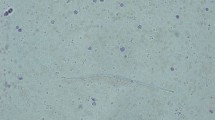Abstract
An enzyme-linked immunosorbent assay (ELISA) was developed for the detection ofEchinococcus coproantigens in fecal samples from dogs, dingoes or foxes infected with eitherE. granulosus orE. multilocularis. The ELISA was based on protein-A-purified polyclonal antibodies [anti-E. granulosus excretory/secretory (E/S) antigens]. The specificity of the assay as determined in 155 samples derived from carnivores that were free of helminth infection (n=37) or infected with non-Echinococcus cestodes (n=76) or with various nematodes (n=42) was found to be 98% overall. The diagnostic sensitivity was strongly dependent on the homologous worm burden. All 13 samples from foxes harboring >1,000E. multilocularis worms and 13 of 15 (87%) samples from dogs or dingoes containing >200E. granulosus worms were ELISA-positive, whereas 34 of 46 samples from foxes harboring <1,000E. multilocularis and 9 of 10 samples from dogs or dingoes bearing <200E. granulosus tested negative. Experimental prepatent infections of dogs withE. granulosus revealed positive ELISA reactions within the prepatent period (10–20 days post-infection) for six animals bearing >1,000E. granulosus each; a low worm burden (<1,000 tapeworms/animal) resulted in ELISA positivity in only 2 of 3 animals at 30 days post-infection at the earliest. All five dogs that had been experimentally infected withE. multilocularis tested positive in the coproantigen ELISA as early as on day 5 post-infection.
Similar content being viewed by others
References
Allan JC, Craig PS (1989) Coproantigens in gut tapeworm infections:Hymenolepis diminuta in rats. Parasitol Res 76:68–73
Allan JC, Avila G, Garcia Noval J, Flisser A, Craig PS (1990) Immunodiagnosis of taeniasis by coproantigen detection. Parasitology 101:473–477
Babos S (1962) Untersuchungen über die Serodiagnostik der Echinokokkose. Angew Parasitol 3:2–4
Baumann D, Gottstein B (1987) A double-antibody sandwich ELISA for the detection ofEntamoeba histolytica antigen in stool samples of humans. Trop Med Parasitol 38:81–85
Blunt DS, Gubrud JA, Hildreth MB (1991) Lethal effects of freezingEchinococcus multilocularis eggs at a low temperature. Abstract 205, 66th Annual Meeting of the American Society of Parasitology, Madison, Wisconsin, August 4–8
Craig PS, Macpherson CNL, Nelson GS (1986) The identification of eggs ofEchinococcus by immunofluorescence using a specific antioncospheral monoclonal antibody. Am J Trop Med Hyg 35:152–158
Deplazes P, Eckert J (1988) Untersuchungen zur Infektion des Hundes mitTaenia hydatigena. Schweiz Arch Tierheilkd 128:307–320
Deplazes P, Gottstein B, Stingelin Y, Eckert J (1990) Detection ofTaenia hydatigena coproantigens by ELISA in dogs. Vet Parasitol 36:91–103
Deplazes P, Eckert J, Pawlowski ZS, Machowska L, Gottstem B (1991) An ELISA for diagnostic detection ofTaenia saginata coproantigens in humans. Trans R Soc Trop Med Hyg 85:391–396
Eckert J, Gemmell MA, Soulsby EJL, Matyas Z (eds) (1984) Guidelines for surveillance, prevention and control of echinococcosis/hydatidosis. World Health Organization, Geneva, pp 1–147
Eckert J, Thompson RCA, Michael SA, Kumaratilake LM, El-Sawah HM (1989)Echinococcus granulosus of camel origin: development in dogs and parasite morphology. Parasitol Res 75:536–544
Eckert J, Deplazes P, Ewald D, Gottstein B (1991) Parasitologische und immunologische Methoden zum Nachweis vonEchinococcus multilocularis bei Füchsen. Mitt Österr Ges Tropenmed Parasitol 13:25–30
Gasser RB, Lightowlers MW, Obendorf DL, Jenkins DJ, Rickard MD (1988) Evaluation of a serological test system for the diagnosis of naturalEchinococcus granulosus infection in dogs usingE. granulosus protoscolex and oncosphere antigens. Aust Vet J 65:369–373
Gottstein B (1985) Purification and characterisation of a specific antigen fromEchinococcus multilocularis. Parasite Immunol 7:201–212
Gottstein B, Mowatt MR (1991) Sequencing and characterization of anE. multilocularis DNA probe and its use in the polymerase chain reaction. Mol Biochem Parasitol 44:183–194
Gottstein B, Deplazes P, Eckert J, Müller B, Schott E, Helle O, Boujon P, Wolff K, Wandeler A, Schwiete U, Moegle H (1991a) Serological (Em2-ELISA) and parasitological examinations of fox populations forEchinococcus multilocularis infections. Zentralbl Veterinärmed [B] 38:161–168
Gottstein B, Deplazes P, Tanner I, Skaggs JS (1991b) Diagnostic identification ofTaenia saginata with the polymerase chain reaction. Trans R Soc Trop Med Hyg 85:248–249
Jenkins DJ, Rickard MD (1985) Specific antibody response toTaenia hydatigena, Taenia pisiformis andEchinococcus granulosus infection in dogs. Aust Vet J 62:72–78
Jenkins DJ, Rickard MD (1986) Specific antibody responses in dogs experimentally infected withEchinococcus granulosus. Am J Trop Med Hyg 35:345–349
Jenkins DJ, Morris B (1991) Unusually heavy infections ofEchinococcus granulosus in wild dogs in south-eastern Australia. Aust Vet J 68:36–37
Jenkins DJ, Gasser RB, Zeyhle E, Romig T, Macpherson CNL (1990) Assessment of a serological test for the detection ofEchinococcus granulosus infection in dogs in Kenya. Acta Trop (Basel) 47:245–248
Jenkins DJ, Gasser RB, Romig T, Zeyhle E (1991) Antibody response against naturalTaenia hydatigena infection in dogs in Kenya. Int J Parasitol 21:251–253
Thompson RCA (1975) Studies on equine hydatidosis in Great Britain. PhD Thesis, University of London
Thompson RCA (1986) Biology and systematics ofEchinococcus. In: Thompson RCA (ed) The biology ofEchinococcus and hydatid disease. Allen & Unwin, London, pp 5–43
Thompson RCA, Eckert J (1982) The production of eggs byEchinococcus multilocularis in the laboratory following in vivo and in vitro development. Z Parasitenkd 68:227–234
Yamashita J, Ohbayashi M, Konno S (1956) Studies on echinococcosis: III. On experimental infections in dogs, especially on the development ofEchinococcus granulosus (Batsch, 1786). Jpn J Vet Res 4:113–122
Author information
Authors and Affiliations
Additional information
Dedicated to Prof. K.T.F. Friedhoff on the occasion of his 60th birthday
Rights and permissions
About this article
Cite this article
Deplazes, P., Gottstein, B., Eckert, J. et al. Detection ofEchinococcus coproantigens by enzyme-linked immunosorbent assay in dogs, dingoes and foxes. Parasitol Res 78, 303–308 (1992). https://doi.org/10.1007/BF00937088
Accepted:
Issue Date:
DOI: https://doi.org/10.1007/BF00937088




